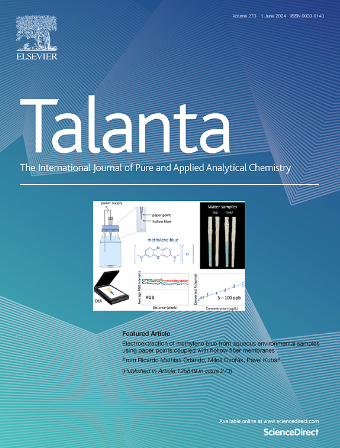双金属氧化物(CoNi2O4)纳米酶作为ROS独立的抗坏血酸检测计算研究
IF 6.1
1区 化学
Q1 CHEMISTRY, ANALYTICAL
引用次数: 0
摘要
本文通过两步水热退火工艺成功合成了尖晶石CoNi2O4纳米花(NFs),并证明其具有内在的酶模拟活性。CoNi2O4 NFs可以有效地将显色底物3,3 ',5,5 ' -四甲基联苯胺(TMB)氧化为x-TMB,其催化行为符合低常数(Km = 0.0143 mM) Michaelis-Menten方程的酶动力学。创新的是,实验数据和密度泛函理论(DFT)计算揭示了脊柱CoNi2O4NFs的稳定结构和机制,在很宽的温度范围内表现出类似氧化酶的活性和活性氧的不依赖性。据此,研制了一种快速灵敏检测抗坏血酸(AA)的比色生物传感器,具有良好的稳定性、选择性、灵敏度和低检测限(0.44 μM)。将该传感器应用于维生素C胶囊和新鲜柠檬果中,具有良好的重复性和可行性。DFT和分子模拟(MD)计算表明,钴原子是催化转化的最佳位点,而TMB分子中的胺基是最佳的亲核攻击位点。本文章由计算机程序翻译,如有差异,请以英文原文为准。

Bimetallic oxide (CoNi2O4) nanozyme as ROS independent for ascorbic acid detection with computational study
Herein, spinel CoNi2O4 nanoflowers (NFs) were successfully synthesized by a two-step hydrothermal annealing process and testified to have intrinsic enzyme mimic activities. The CoNi2O4 NFs can effectively oxidize the chromogenic substrate 3, 3′, 5, 5′-tetramethylbenzidine (TMB) to ox-TMB showing catalytic behavior that follows enzyme kinetics of Michaelis-Menten equation with a low constant (Km = 0.0143 mM). Innovatively, experimental data and Density Functional Theory (DFT) calculations disclosed the stable structure and mechanism of spinal CoNi2O4NFs, which demonstrated oxidase-like activity and reactive oxygen species independence across a wide temperature range. Accordingly, a colorimetric biosensor for rapid and sensitive detection of ascorbic acid (AA) was successfully developed, displaying excellent stability, selectivity, sensitivity and low limit of detection (0.44 μM). This biosensor was applied to vitamin C capsules and fresh lemon fruit, showing favorable reproducibility and feasibility. DFT and molecular modeling (MD) calculations indicate a cobalt atom as the optimal site for catalytic conversion, while the amine group in the TMB molecule is the optimal nucleophilic attack site.
求助全文
通过发布文献求助,成功后即可免费获取论文全文。
去求助
来源期刊

Talanta
化学-分析化学
CiteScore
12.30
自引率
4.90%
发文量
861
审稿时长
29 days
期刊介绍:
Talanta provides a forum for the publication of original research papers, short communications, and critical reviews in all branches of pure and applied analytical chemistry. Papers are evaluated based on established guidelines, including the fundamental nature of the study, scientific novelty, substantial improvement or advantage over existing technology or methods, and demonstrated analytical applicability. Original research papers on fundamental studies, and on novel sensor and instrumentation developments, are encouraged. Novel or improved applications in areas such as clinical and biological chemistry, environmental analysis, geochemistry, materials science and engineering, and analytical platforms for omics development are welcome.
Analytical performance of methods should be determined, including interference and matrix effects, and methods should be validated by comparison with a standard method, or analysis of a certified reference material. Simple spiking recoveries may not be sufficient. The developed method should especially comprise information on selectivity, sensitivity, detection limits, accuracy, and reliability. However, applying official validation or robustness studies to a routine method or technique does not necessarily constitute novelty. Proper statistical treatment of the data should be provided. Relevant literature should be cited, including related publications by the authors, and authors should discuss how their proposed methodology compares with previously reported methods.
 求助内容:
求助内容: 应助结果提醒方式:
应助结果提醒方式:


